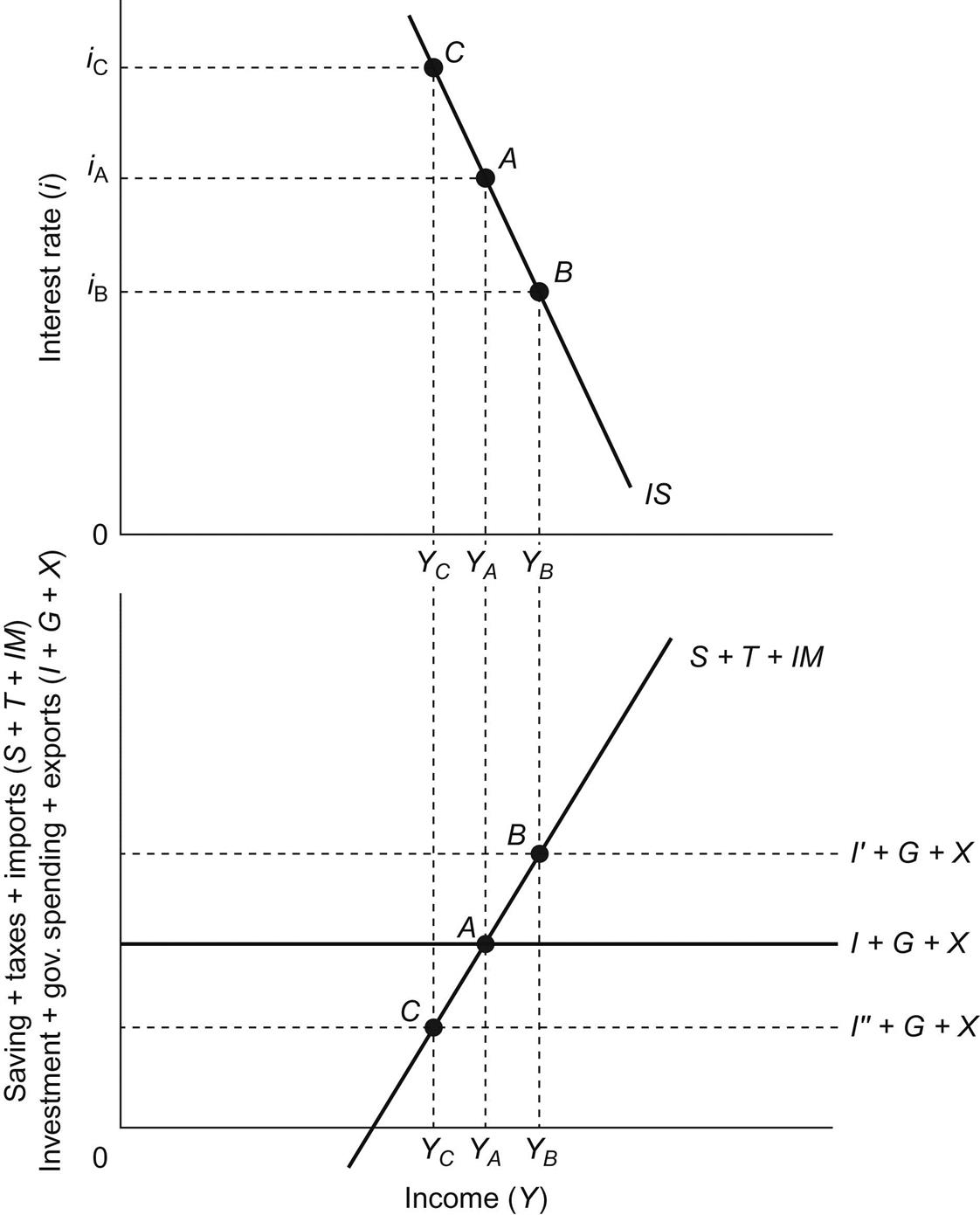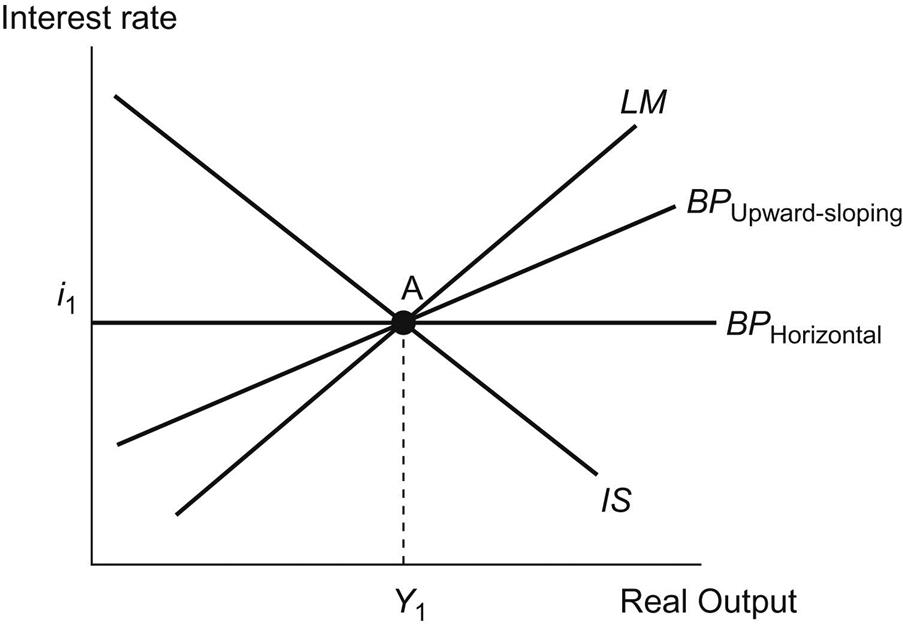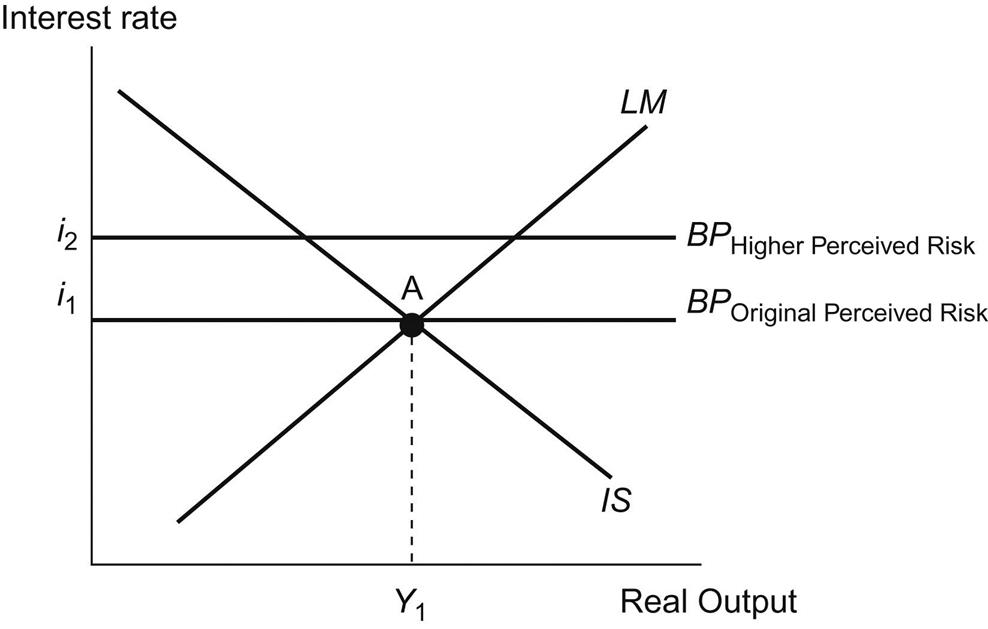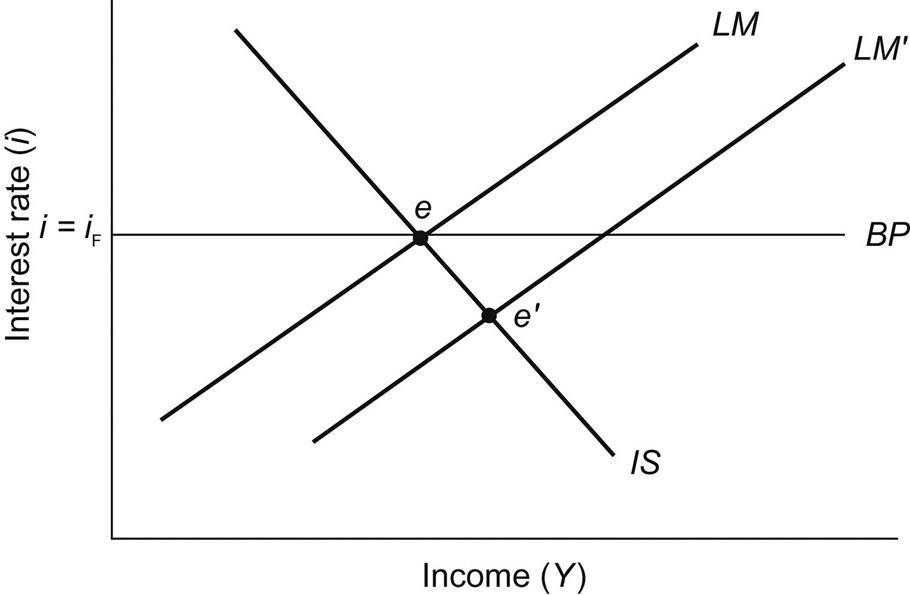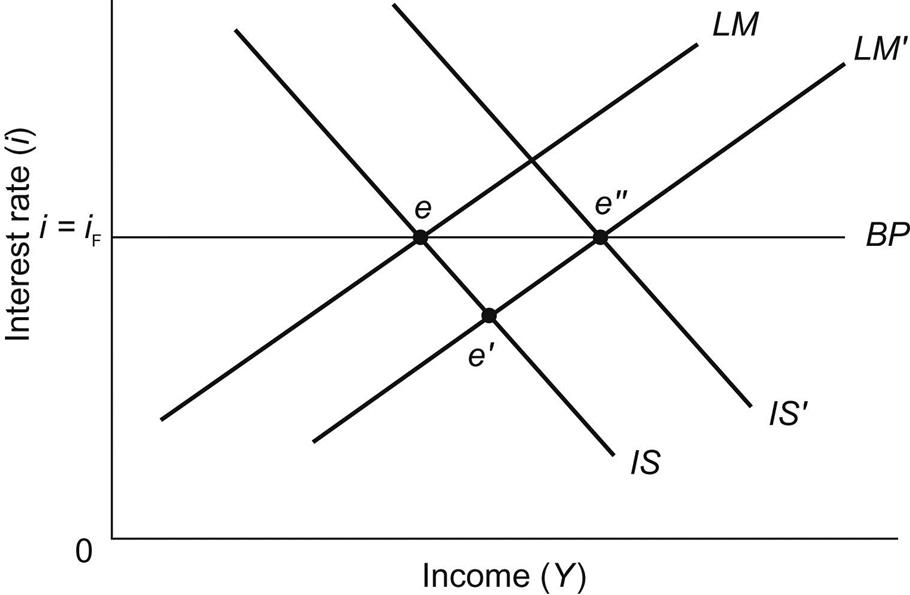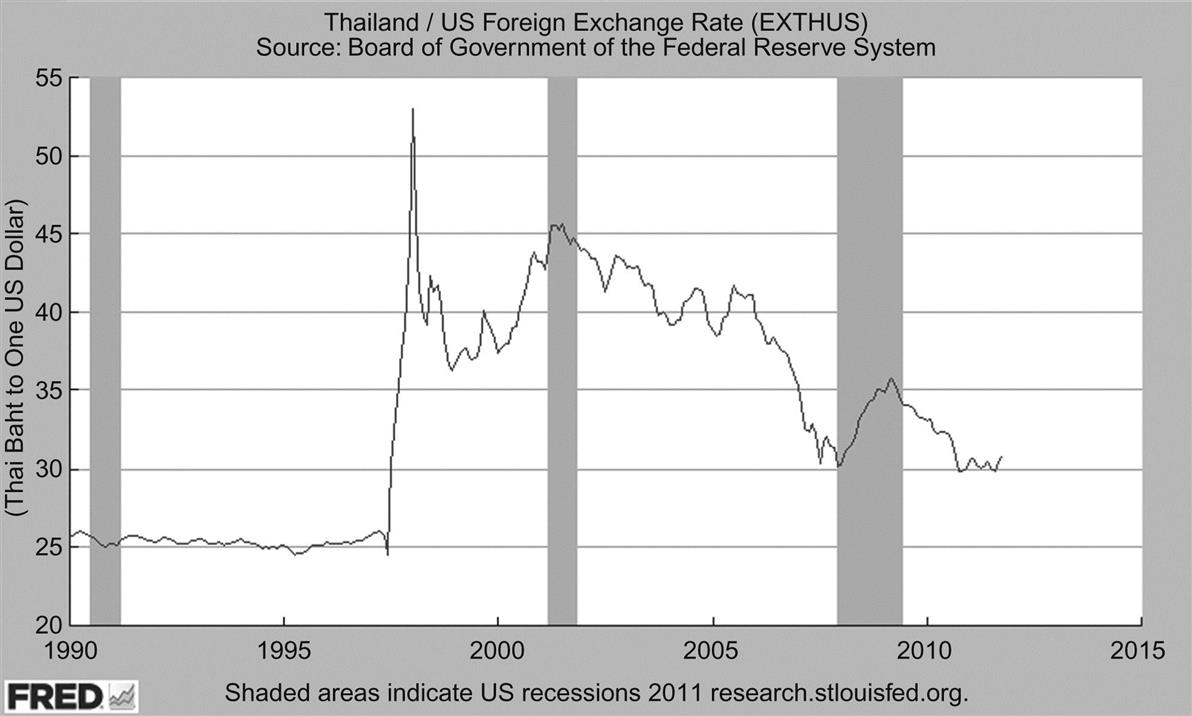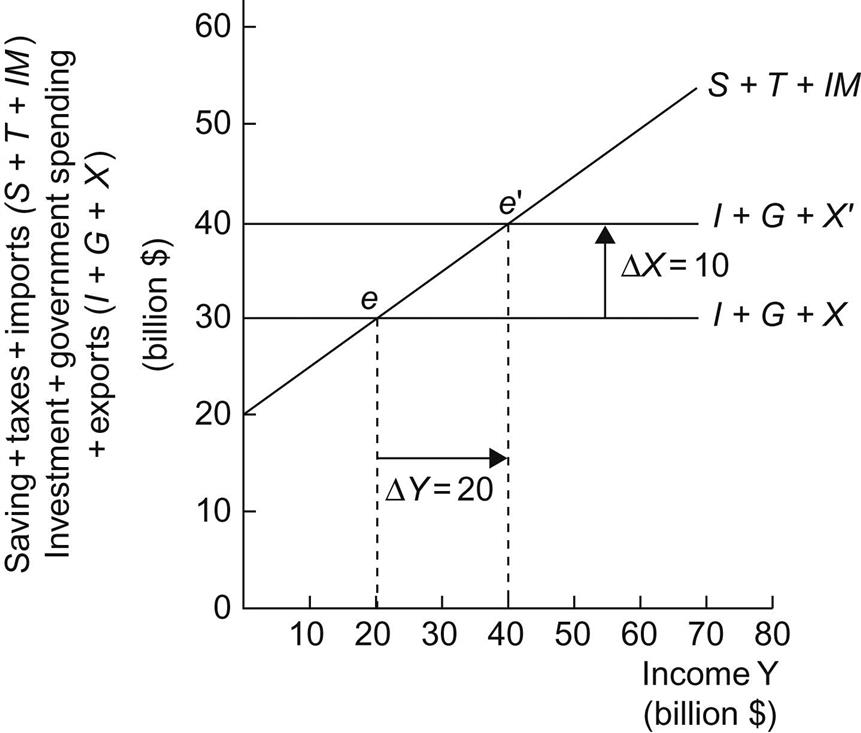The IS-LM-BP Approach
Abstract
This chapter considers economic goals from the point of view of an open economy, in which authorities must consider the impact of policy on balance of trade, capital flows, and exchange rates. It describes the major tools of macroeconomic policy used to achieve macroeconomic equilibrium: fiscal policy and monetary policy. The IS-LM-BP macroeconomic equilibrium diagram, in which IS represents goods market equilibrium, LM represents money market equilibrium, and BP represents balance of payments equilibrium, is examined in detail. Economic equilibrium requires that all three markets be in balance. Monetary and fiscal policy under fixed and floating exchange rates is discussed. The Asian financial crisis is used as an example to illustrate using the IS-LM-BP framework to explain macroeconomic events. The final section of the chapter summarizes the international debate concerning fiscal and monetary policy coordination.
Keywords
Asian financial crisis; balance of payments; balance of trade; fiscal policy; fixed exchange rate; floating exchange rate; IS-LM-BP diagram; macroeconomics; monetary policy; Mundell–Fleming model; open economy
An economy open to international trade and payments will face different problems than an economy closed to the rest of the world. The typical introductory economics presentation of macroeconomic equilibrium and policy is a closed-economy view. Discussions of economic adjustments required to combat unemployment or inflation do not consider the rest of the world. Clearly, this is no longer an acceptable approach in an increasingly integrated world.
In the open economy, we can summarize the desirable economic goals as being the attainment of internal and external balance. Internal balance means a steady growth of the domestic economy consistent with a low unemployment rate. External balance is the achievement of a desired trade balance or desired international capital flows. In principles of economics classes, the emphasis is on internal balance. By concentrating solely on internal goals like inflation, unemployment, and economic growth, simpler-model economies may be used for analysis. A consideration of the joint pursuit of internal and external balance calls for a more detailed view of the economy. The slight increase in complexity yields a big payoff in terms of a more realistic view of the problems facing the modern policy maker. It is no longer a question of changing policy to change unemployment or inflation at home. Now the authorities must also consider the impact on the balance of trade, capital flows, and exchange rates.
The Internal and External Macroeconomic Equilibrium
The major tools of macroeconomic policy are fiscal policy (government spending and taxation) and monetary policy (central bank control of the money supply). These tools are used to achieve macroeconomic equilibrium. We assume that macroeconomic equilibrium requires equilibrium in three major sectors of the economy:
1. Goods market equilibrium. The quantity of goods and services supplied is equal to the quantity demanded. This is represented by the IS curve.
2. Money market equilibrium. The quantity of money supplied is equal to the quantity demanded. This is represented by the LM curve.
3. Balance of payments equilibrium. The current account deficit is equal to the capital account surplus, so that the official settlements definition of the balance of payments equals zero. This is represented by the BP curve.
We will analyze the macroeconomic equilibrium with a graph that summarizes equilibrium in each market. Fig. 13.1 displays the IS-LM-BP diagram. This graph illustrates various combinations of the domestic interest rate (i) and domestic national income (Y) that yield an equilibrium in the three markets considered here.
The IS Curve
First, let us examine the IS curve, which represents combinations of i and Y that provide equilibrium in the goods market when everything else (like the price level) is held constant. Y refers to the total output as well as the total income in the economy. Equilibrium occurs when the output of goods and services is equal to the quantity of goods and services demanded. In principles of economics classes, macroeconomic equilibrium is said to exist when the “leakages equal the injections” of spending in the economy. More precisely, domestic saving (S), taxes (T), and imports (IM) represent income received that is not spent on domestic goods and services—the leakages from spending. The offsetting injections of spending are represented by investment spending (I), government spending (G), and exports (X). Investment spending is the spending of business firms for new plants and equipment.
Equilibrium occurs when
(13.1)
When the leakages from spending equal the injections, then the value of income received from producing goods and services will be equal to total spending, or the quantity of output demanded. The IS curve in Fig. 13.1 depicts the various combinations of i and Y that yield the equality in Eq. (13.1). We now consider why the IS curve is downward sloping.
We assume that S and IM are both functions of income and that taxes are set by governments independent of income. The higher that domestic income, the more domestic residents want to save. Furthermore, the higher income will also enable domestic residents to spend more on imports. In the bottom panel of Fig. 13.2, the S+T+IM line is upward sloping. This illustrates that the higher domestic income rises, the greater are savings plus taxes plus imports. Investment is assumed to be a function of the domestic interest rate and so does not change as current domestic income changes. Similarly, exports are assumed to be determined by foreign income (they are foreign imports) and so do not change as domestic income changes. Finally, government spending is set independent of income. Since I, G, and X are all independent of current domestic income, the I+G+X line in the bottom panel of Fig. 13.2 is drawn as a horizontal line.
Eq. (13.1) indicated that equilibrium occurs at that income level where S+T+IM=I+G+X. In the bottom panel of Fig. 13.2, point A represents an equilibrium point with an equilibrium level of income YA. In the upper panel of the figure, YA is shown to be consistent with point A on the IS curve. This point is also associated with a particular interest rate iA.
To understand why the IS curve slopes downward, consider what happens as the interest rate varies. Suppose the interest rate falls. At the lower interest rate, more potential investment projects become profitable (firms will not require as high a return on investment when the cost of borrowed funds falls), so investment increases as illustrated in the move from I+G+X to I′+G+X in Fig. 13.2. At this higher level of investment spending, equilibrium income increases to YB. Point B on the IS curve depicts this new goods market equilibrium, with a lower equilibrium interest rate iB and higher equilibrium income YB.
Finally, consider what happens when the interest rate rises. Investment spending will fall, because fewer potential projects are profitable as the cost of borrowed funds rises. At the lower level of investment spending, the I+G+X curve shifts down to I″+G+X in Fig. 13.2. The new equilibrium point C is consistent with the level of income YC. In the IS diagram in the upper panel we see that point C is consistent with equilibrium income level YC and equilibrium interest rate iC. The other points on the IS curve are consistent with alternative combinations of income and interest rate that yield equilibrium in the goods market.
We must remember that the IS curve is drawn holding the domestic price level constant. A change in the domestic price level will change the price of domestic goods relative to foreign goods. If the domestic price level falls with a given interest rate, then investment, government spending, taxes, and saving will not change. However, domestic goods are now cheaper relative to foreign goods, leading to exports increasing and imports falling. The rise in the I+G+X curve and the fall in the S+T+IM curve would both increase income. Because income increases with a constant interest rate, the IS curve shifts to the right. A rise in the domestic price level would cause the IS curve to shift left.
The LM Curve
The LM curve in Fig. 13.1 displays the alternative combinations of i and Y at which the demand for money equals the supply. Fig. 13.3 provides a derivation of the LM curve. The left panel shows a money demand curve labeled Md and a money supply curve labeled Ms. The horizontal axis measures the quantity of money and the vertical axis measures the interest rate. Note that the Ms curve is vertical. This is so because the central bank can choose any money supply it wants, independent of the interest rate. The actual value of the money supply chosen is M0. The money demand shows, for a fixed amount of wealth, how much people are willing to hold in money form, as opposed to interest-bearing assets. The money demand curve slopes downward, indicating that the higher the interest rate, the lower the quantity of money demanded.
The inverse relationship between the interest rate and quantity of money demanded is a result of the role of interest as the opportunity cost of holding money. Since money earns no interest, the higher the interest rate, the more you must give up to hold money, so less money is held.
The initial money market equilibrium occurs at point A with interest rate iA. The initial money demand curve, Md, is drawn for a given level of income. If income increased, then the demand for money would increase, as seen in the shift from Md to Md′. Money demand increases because, at the higher level of income, people want to hold more money to support the increased spending on transactions.
Now let us consider why the LM curve has a positive slope. Suppose initially there is equilibrium at point A with the interest rate at iA and income at YA in Fig. 13.3. If income increases from YA to YB, money demand increases from Md to Md′. If the interest rate remains at iA, there will be an excess demand for money. This is shown in the left panel of Fig. 13.3, as the quantity of money demanded is now MA′. With the higher income, money demand is given by Md′. At iA, point A′ on the money demand curve is consistent with the higher quantity of money demanded, MA′. Since the money supply remains constant at M0, there will be an excess demand for money given by MA′ −M0. The attempt to increase money balances above the quantity of money outstanding will cause the interest rate to rise until a new equilibrium is established at point B. This new equilibrium is consistent with a higher interest rate iB and a higher income YB. Points A and B are both indicated on the LM curve in the right panel of Fig. 13.3. The rest of the LM curve reflects similar combinations of equilibrium interest rates and income.
The LM curve is drawn for a specific money supply. If the supply of money increases, then money demand will have to increase to restore equilibrium. This requires a higher Y or lower i, or both, so the LM curve will shift right. Similarly, a decrease in the money supply will tend to raise i and lower Y, and the LM curve will shift to the left.
The BP Curve
The final curve portrayed in Fig. 13.1 is the BP curve. The BP curve gives the combinations of i and Y that yield balance of payments equilibrium. The BP curve is drawn for a given domestic price level, a given exchange rate, and a given net foreign debt. Equilibrium occurs when the current account surplus is equal to the capital account deficit. Recall from Chapter 3, The Balance of Payments that if there is a current account deficit, then it has to be financed by a capital account surplus.
Fig. 13.4 illustrates the derivation of the BP curve. The lower panel of the figure shows a CS line, representing the current account surplus, and a CD line, representing the capital account deficit. Realistically, the current account surplus may be negative, which would indicate a deficit. Similarly, the capital account deficit may be negative, indicating a surplus. The CS line is downward sloping because as income increases, domestic imports increase and the current account surplus falls. The capital account is assumed to be a function of the interest rate and is, therefore, independent of income and a horizontal line.
Equilibrium occurs when the current account surplus equals the capital account deficit, so that the official settlements balance of payments is zero. Initially, equilibrium occurs at point A with income level YA and interest rate iA. If the interest rate increases, then domestic financial assets are more attractive to foreign buyers and the capital account deficit falls to CD′. At the old income level YA, the current account surplus will exceed the capital account deficit, and income must increase to YB to provide a new equilibrium at point B. Points A and B on the BP curve in Fig. 13.4 illustrate that, as i increases, Y must also increase to maintain equilibrium. Only an upward sloping BP curve will provide combinations of i and Y consistent with equilibrium.
In deriving the BP curve, we assumed that higher interest rates in the domestic economy would attract foreign investors and decrease the capital account deficit. If capital is perfectly mobile for any income level, then any deviation of the domestic interest rate from the foreign rate would cause investors to attempt to hold only the high return assets. Therefore, the BP curve becomes perfectly horizontal in the case of perfectly mobile capital. If foreign capital is not perfectly available then the BP curve will be upward sloping. If there are many restrictions to capital mobility then the BP curve will become close to vertical. Fig. 13.5 illustrates a perfectly horizontal BP curve and an upward sloping BP curve.
It is also important to realize that the BP curve can shift whether it is upward sloping or horizontal. For example, a changing foreign perception of the substitutability shifts the BP curve. This is an intercept change, and thus the entire schedule shifts. For example, in Fig. 13.6 one can see how an increase in the perception of riskiness of a country’s assets causes the BP curve to shift upward. Thus, interest rates are not equal across countries even with perfect capital mobility. For example, Indonesia may have a positive risk premium, so that investors demand a certain added premium for financing Indonesia’s trade deficits. However, as long as that particular risk premium is paid, investors are willing to finance the trade deficit.
Equilibrium
Equilibrium for the economy requires that all three markets—the goods market, the money market, and the balance of payments—be in equilibrium. This occurs when the IS, LM, and BP curves intersect at a common equilibrium level of the interest rate and income. In Fig. 13.1, point e is the equilibrium point that occurs at the equilibrium interest rate ie and the equilibrium income level Ye. Until some change occurs that shifts one of the curves, the IS-LM-BP equilibrium will be consistent with all goods produced being sold, money demand equal to money supply, and a current account surplus equal to a capital account deficit that yields a zero balance on the official settlements account.
Monetary Policy Under Fixed Exchange Rates
With fixed exchange rates, the domestic central bank is not free to conduct monetary policy independently from the rest of the world. If domestic and foreign assets are perfect substitutes, then they must yield the same return to investors. Clearly, in this case there is no room for central banks to conduct an independent monetary policy under fixed exchange rates.
Fig. 13.7 illustrates this situation. With perfect asset substitutability, the BP curve is a horizontal line at the domestic interest rate i, which equals the foreign interest rate iF. Any rate higher than iF results in large (infinite) capital inflows, while any lower rate yields large capital outflows. Only at iF is the balance of payments equilibrium obtained.
Suppose the central bank increases the money supply so that the LM curve shifts from LM to LM′. The IS-LM equilibrium is now shifted from e to e′. While e′ results in equilibrium in the money and goods market, there will be a large capital outflow and large official settlements balance deficit. This will pressure the domestic currency to depreciate on the foreign exchange market. To maintain the fixed exchange rate, the central bank must intervene and sell foreign exchange to buy domestic currency. The foreign exchange market intervention will decrease the domestic money supply and shift the LM curve back to LM to restore the initial equilibrium at e. With perfect capital mobility, this would all happen instantaneously, so that no movement away from point e is ever observed. Any attempt to lower the money supply and shift the LM curve to the left would have just the reverse effect on the interest rate and intervention activity.
If capital mobility is less than perfect, then the central bank has some opportunity to vary the money supply. Still, the maintenance of the fixed exchange rate will require an ultimate reversal of policy in the face of a constant foreign interest rate. The process is essentially just drawn out over time rather than occurring instantly.
Fiscal Policy Under Fixed Exchange Rates
A change in government spending or taxes will shift the IS curve. Suppose an expansionary fiscal policy is desired. Fig. 13.8 illustrates the effects. With fixed exchange rates, perfect asset substitutability, and perfect capital mobility, the BP curve is a horizontal line at i=iF. An increase in government spending shifts the IS curve right to IS′. The domestic equilibrium shifts from point e to e′, which would mean a higher interest rate and higher income. Since point e′ is above the BP curve, the official settlements balance of payments moves to a surplus because of a reduced capital account deficit associated with the higher domestic interest rate. To stop the domestic currency from appreciating, the central bank must increase the money supply and buy foreign exchange with domestic money. The increase in the money supply shifts the LM curve to the right. When the money supply has increased enough to move the LM curve to LM′ in Fig. 13.8, equilibrium is restored at point e″. Point e″ has the interest rate back at i=iF, and yet income has increased.
This result is a significant difference from the monetary policy expansion considered in the preceding section. With fixed exchange rates and perfect capital mobility, monetary policy was seen to be ineffective in changing the level of income. This was so because there was no room for independent monetary policy with a fixed exchange rate. In contrast, fiscal policy will have an effect on income and can be used to stimulate the domestic economy.
Monetary Policy Under Floating Exchange Rates
We now consider a world of flexible exchange rates and perfect capital mobility. The notable difference between the analysis in this section and the fixed exchange rate stories of the previous two sections is that with floating rates the central bank is not obliged to intervene in the foreign exchange market to support a particular exchange rate. With no intervention, the current account surplus will equal the capital account deficit so that the official settlements balance equals zero. In addition, since the central bank does not intervene to fix the exchange rate, the money supply can change to any level desired by the monetary authorities. This independence of monetary policy is one of the advantages of flexible exchange rates.
The assumptions of perfect substitutability of assets and perfect capital mobility will result in i=iF as before. Once again, the BP curve will be a horizontal line at i=iF. Only now, equilibrium in the balance of payments will mean a zero official settlements balance. Changes in the exchange rate will cause shifts in the IS curve. With fixed domestic and foreign goods prices, depreciation of the domestic currency will make domestic goods relatively cheaper and will stimulate domestic exports. Since net exports are part of total spending, the IS curve will shift rightward. A domestic currency appreciation will decrease domestic net exports and cause the IS curve to shift to the left.
Fig. 13.9 illustrates the effects of an expansionary monetary policy. The increase in the money supply shifts the LM curve to the right to LM′. The interest rate and income existing at point e′ would yield equilibrium in the money and goods markets but would cause a larger capital account deficit (and official settlements deficit) since the domestic interest rate would be less than iF. Since this is a flexible exchange rate system, the official settlements deficit is avoided by adjusting the exchange rate to a level that restores equilibrium. Specifically, the pressure of the official settlements deficit will cause the domestic currency to depreciate. This depreciation is associated with a rightward shift of the IS curve as domestic exports increase. When the IS curve shifts to IS′, the new equilibrium is obtained at e″. At e″, income has increased and the domestic interest rate equals the foreign rate.
Had there been a monetary contraction instead of an expansion, the story would have been reversed. A temporarily higher interest rate would decrease the capital account deficit, causing pressure for the domestic currency to appreciate. As domestic net exports are decreased, the IS curve shifts to the left until a new equilibrium is established at a lower level of income and the original i=iF is restored.
In contrast to the fixed exchange rate world, monetary policy can change the level of income with floating exchange rates. Since the exchange rate adjusts to yield balance of payments equilibrium, the central bank can choose its monetary policy independent of other countries’ policies. This world of flexible exchange rates and perfect capital mobility is often called the Mundell–Fleming model of the open economy. (Robert Mundell, Nobel Laureate in Economics in 1999, and Marcus Fleming were two early researchers who developed models along the lines of those presented here.)
Fiscal Policy Under Floating Exchange Rates
An expansionary fiscal policy caused by a tax cut or increased government spending will shift the IS curve to the right. Earlier it was shown that with fixed exchange rates, such a policy would result in a higher domestic income level. With flexible exchange rates, we will see that the story is much different.
In Fig. 13.10, the expansionary fiscal policy shifts the IS curve right, from IS to IS′. This shift would result in an intermediate equilibrium at point e′. At e′, the goods market and money market will be in equilibrium, but there will be an official settlements surplus because of the lower capital account deficit induced by the higher interest rate at e′. Since the exchange rate is free to adjust to eliminate the balance of payments surplus, the intersection of the IS and LM curves cannot remain above the BP curve.
The official settlements surplus causes the domestic currency to appreciate. This appreciation will reduce domestic exports and increase imports. As net exports fall, the IS curve shifts left. When the IS curve has returned to the initial equilibrium position that passes through point e, equilibrium is restored in all markets. Note that the final equilibrium occurs at the initial level of i and Y. With floating exchange rates, fiscal policy is ineffective in shifting the level of income. When an expansionary fiscal policy has no effect on income, complete crowding out has occurred. Crowding out means that the positive effect on income is offset by a reduction of income from another factor. For example, when the economy moves from e to e′ the investment spending will be reduced. This will partially crowd out the positive effect of the expansionary fiscal policy. However, when the domestic currency appreciates and the economy returns to e, then the crowding out effect occurs because the currency appreciation induced by the expansionary fiscal policy reduces net exports to a level that just offsets the fiscal policy effects on income.
Using the IS-LM-BP Approach: The Asian Financial Crisis
The Asian financial crisis, illustrated in Fig. 13.11, provides an interesting example of how the IS-LM-BP framework can be used to explain real-world events. In early 1997, foreign investors became worried that assets in Thailand were riskier than in other countries. Thus, the Thai assets and assets in other countries were no longer perfect substitutes. Instead, foreign investors required a positive risk premium to hold Thai assets. This shifted the BP curve up from BP1 to BP2. The original starting point A was no longer a viable equilibrium, because capital flows were no longer available at the same interest rates. To protect the fixed exchange rate, the Bank of Thailand had to buy Thai baht and sell dollar foreign reserves, resulting in a reduction in money supply in Thailand. This shifted the LM curve from LM1 to LM2. This monetary tightening also caused the domestic interest rates to sharply increase, crowding out domestic private investment. Thailand went into a deep recession.
Speculators sensed that the Bank of Thailand could not keep on protecting the Thai baht. Therefore they sold their assets denominated in Thai baht and bought dollar assets. This led to further pressure on the Thai baht to depreciate. After a considerable effort in trying to protect the fixed exchange rate, the Thai government and Bank of Thailand decided to allow the exchange rate to float on July 2, 1997. The Thai baht immediately depreciated from 25 baht per dollar to over 50 baht per dollar. With a floating rate the response to the risk premium demanded by the speculators looks very different. In Fig. 13.12, monetary policy, i.e., the LM curve, is unaffected. However, the sharp depreciation that happened once the Thai baht was allowed to float resulted in an increase in the domestic competitiveness, shown in Fig. 13.12 as a shift in the IS curve from IS1 to IS2. The depreciation led to the beginning of a recovery for Thailand.
Speculators who sold their assets denominated in Thai baht and bought dollar assets were rewarded when the Thai baht sharply depreciated. Therefore they continued their speculation activity in neighboring countries, causing the crisis to spread in Southeast Asia. Within 6 months speculators successfully attacked the fixed exchange rates in four neighboring countries, Indonesia, South Korea, Philippines, and Malaysia. In each case the countries allowed their currencies to float after a considerable effort to try to protect the currency.
So why not allow the Thai baht to float earlier? A fixed exchange rate encourages banks and firms not to cover the exchange rate exposure. Thus, banks had short-term loans in dollars and long-term investments in Thai baht. A devaluation of the Thai baht would create difficulty for banks in Thailand, as the cost of paying their debt would exceed the return on their long-term investments. This is typical for many developing countries in that the government encourages local investment and borrows from capital rich developed countries. Thus, banks in Thailand had a large number of loans in dollars and payments in baht. After the depreciation of the dollar, most of the banks and financial firms went bankrupt, with over 50 banks and financial firms taken over by the Thai government in the end of 1997.
International Policy Coordination
From the early 1970s onward, the major developed nations have generally operated with floating exchange rates. The IS-LM-BP framework, analyzed in this chapter, has shown that fiscal and monetary policy can generate large swings in floating exchange rates. Economists have been debating how to coordinate policies across countries, because of the potential disruptive effect of exchange rate volatility on world trade.
The high degree of capital mobility existing among the developed countries suggests that fiscal actions that lead to a divergence of the domestic interest rate from the given foreign interest rate will quickly be undone by the influence of exchange rate changes on net exports, as was illustrated in Fig. 13.10. For example, many economists argue that the sharp increase in the dollar value in the early 1980s was due to the expansionary fiscal policy followed by the US government. How could such exchange rate volatility be minimized? If all nations coordinated their domestic policies and simultaneously stimulated their economies, the world interest rate would rise. Thus, the pressure for an exchange rate change for a particular country (in the above case, the United States) would disappear. The problem illustrated in Fig. 13.10 was that of a single country attempting to follow an expansionary policy while the rest of the world retained unchanged policies, so that iF remains constant. If iF increased at the same time that i increased, the BP curve would shift upward and the balance of payments equilibrium would be consistent with a higher interest rate.
Similarly, changes in exchange rates and net exports induced by monetary policy can be lessened if central banks coordinate policy so that iF shifts with i. There have been instances of coordinated foreign exchange market intervention when a group of central banks jointly followed policies aimed at a depreciation or appreciation of the dollar. These coordinated interventions, intended to achieve a target value of the dollar, also work to bring domestic monetary policies more in line with each other. If the United States has been following an expansionary monetary policy relative to Japan, US interest rates may fall relative to the other country’s rates, so that a larger capital account deficit is induced and pressure for a dollar depreciation results. If the central banks decide to work together to stop the dollar depreciation, the Japanese will buy dollars on the foreign exchange market with their domestic currencies, while the Federal Reserve must sell foreign exchange to buy dollars. This will result in a higher money supply in Japan and a lower money supply in the United States. The coordinated intervention works toward a convergence of monetary policy in each country.
The basic argument in favor of international policy coordination is that such coordination would stabilize exchange rates. Whether exchange rate stability offers any substantial benefits over freely floating rates with independent policies is a matter of much debate. Some experts argue that coordinated monetary policy to achieve fixed exchange rates or to reduce exchange rate fluctuations to within narrow target zones would reduce the destabilizing aspects of international trade in goods and financial assets when currencies become overvalued or undervalued. This view emphasizes that in an increasingly integrated world economy, it seems desirable to conduct national economic policy in an international context rather than by simply focusing on domestic policy goals without a view of the international implications.
An alternative view is that most changes in exchange rates result from real economic shocks and should be considered permanent changes. In this view, there is no such thing as an overvalued or undervalued currency because exchange rates always are in equilibrium given current economic conditions. Furthermore, governments cannot change the real relative prices of goods internationally by driving the nominal exchange rate to some particular level through foreign exchange market intervention, because price levels will adjust to the new nominal exchange rate. This view, then, argues that government policy is best aimed at lowering inflation and achieving governmental goals that contribute to a stable domestic economy.
The debate over the appropriate level and form of international policy coordination has been one of the livelier areas of international finance in recent years. Many leading economists have participated, but a problem at the practical level is that different governments emphasize different goals and may view the current economic situation differently. Ours is a more complex world in which to formulate international policy agreements than is typically viewed in scholarly debate, where it is presumed that governments agree on the current problems and on the impact of alternative policies on those problems. Nevertheless, the research of international financial scholars offers much promise in contributing toward a greater understanding of the real-world complexities government officials must address.
Summary
1. The desired economic outcome in an open economy is to achieve both internal balance and external balance at the same time.
2. Internal balance refers to a domestic equilibrium condition such that goods market and money market are in equilibrium and unemployment is at its natural level.
3. External balance requires the balance of payments to be in equilibrium. The condition implies zero balance on the official settlement—the current account surplus must be equal to the capital account deficit.
4. The IS curve represents the combinations of income and interest rate levels that bring the good market to equilibrium (i.e., leakages equals to injections).
5. The LM curve represents the combinations of income and interest rate levels that bring the money market to equilibrium (i.e., money demand equals to money supply).
6. The BP curve represents the combinations of income and interest rate levels that bring the balance of payments to equilibrium (i.e., current account surplus equals to capital account deficit).
7. The internal and external equilibriums occur when three curves intersect at one point.
8. The factors that shift the IS curve are a change in domestic price level, a change in exchange rate, and a change in fiscal policy variable.
9. The factor that shifts the LM curve is a change in money supply.
10. The slope of the BP curve depends on the degree of capital mobility. In the case of perfect capital mobility between countries, the BP curve is horizontal.
11. The factor that shifts the BP curve is a change in perception of asset substitutability.
12. With perfect substitutability and perfect capital mobility, the domestic interest rate is equal to the foreign interest rate.
13. With fixed exchange rates, a country cannot conduct an independent monetary policy to change domestic income. Only fiscal policy is effective in changing equilibrium income.
14. With floating exchange rates, monetary policy is effective in changing domestic income. However, fiscal policy has no effect on income because of a complete crowding out effect from the balance of payments adjustment.
15. International policy coordination is an idea that aims to stabilize the exchange rates by coordinating each country’s fiscal and monetary policies to achieve the best international outcome.
Exercises
1. Explain the difference between a closed-economy and an open economy. Explain also how the pursuit of internal equilibrium will be different between the two types of economies.
2. Consider the IS-LM-BP model of an open economy with a constant price level, perfect asset substitutability, and perfect capital mobility. The economy is initially in both internal and external equilibrium.
a. Explain why the BP curve is a horizontal line at i=iF, where i is the domestic nominal interest rate and iF is the foreign nominal interest rate.
b. Define the internal equilibrium and external equilibrium of the economy, respectively.
3. From question 2, suppose now that the domestic economy decides to reduce its money supply.
a. What are the initial effects of this monetary policy on the goods market, the money market, the foreign exchange market, and the balance of payments of the domestic economy? Which curve(s) will shift?
b. What is the adjustment mechanism under a fixed exchange rate regime? Illustrate and explain which curve(s) will shift during the adjustment, and then compare the new equilibrium with the initial equilibrium.
c. What is the adjustment mechanism under a flexible exchange rate regime? Illustrate and explain which curve(s) will shift during the adjustment, and then compare the new equilibrium with the initial equilibrium.
4. From question 2, suppose now that the domestic government decides to increase the government spending.
a. What are the initial effects of this fiscal policy on the goods market, the money market, the foreign exchange market, and the balance of payments of the domestic economy? Which curve(s) will shift?
b. What is the adjustment mechanism under a fixed exchange rate regime? Illustrate and explain which curve(s) will shift during the adjustment, and then compare the new equilibrium with the initial equilibrium.
c. What is the adjustment mechanism under a flexible exchange rate regime? Illustrate and explain which curve(s) will shift during the adjustment, and then compare the new equilibrium with the initial equilibrium.
5. If a country has a surplus balance of payments, what will be the appropriate government policy to restore the balance of payments back to equilibrium? What effects might this have on the country’s income?
6. What is an international policy coordination? Explain why it is difficult to adopt an international policy coordination in practice.
Appendix A The Open Economy Multiplier
We can use the macroeconomic model developed in this chapter to analyze the effects of changes in spending on the equilibrium level of national income, assuming the interest rate is unchanged. We begin with the basic macroeconomic equilibrium conditions seen in the bottom half of Fig. 13.2:
(13.A1)
In equilibrium, the planned level of saving plus taxes plus imports must equal the planned level of investment plus government spending plus exports. To find the equilibrium levels of national income (Y) and net exports (X −IM), we must make some assumptions regarding the variables in Eq. (13.A1). Specifically, we assume that saving and imports both depend on the level of national income. The greater the domestic income, the more people want to save, and the more they want to spend on imports. The fraction of any extra income that people want to save is called the marginal propensity to save, which we will denote as s. The fraction of any extra income that people want to spend on imports is called the marginal propensity to import, which we will denote as m. So, S=sY and IM=mY. The rest of the variables in Eq. (13.A1)—T, I, G, and X—are assumed to be exogenously determined by factors other than domestic income.
With these assumptions, we can substitute the new specifications of S and IM and rewrite Eq. (13.A1) as
(13.A2)
Gathering our Y terms and subtracting T from each side of the equation, we have (s+m) Y=I+G+X−T. Solving for the equilibrium level of Y yields
(13.A3)
If I, G, or X increased by $1, the equilibrium level of Y would increase by 1/(s+m) times $1. An increase in T would cause Y to fall. The value of 1/(s+m) is known as the open economy multiplier. This multiplier is equal to the reciprocal of the marginal propensity to save (s) plus the marginal propensity to import (m). Since s and m will both be some fraction less than 1, we expect this multiplier to exceed 1, so that an increase in I, G, or X spending would cause the equilibrium level of national income to rise by more than the change in spending.
Let us consider an example of this multiplier effect. Suppose that we return to the model of Fig. 13.2 as redrawn in Fig. 13.A1. In this model economy, the marginal propensity to save is 0.3, the marginal propensity to import is 0.2, taxes equal 20, and investment, government spending, and exports each equal 10 (assume the units are billions of dollars). In this case, the macroeconomic model is given by
(13.A4)
and
(13.A5)
These two equations are drawn in Fig. 13.A1 as the S+T+IM line and the I+G+X line. The point of intersection occurs at e, where the equilibrium level of national income equals $20 billion.
The equilibrium level of income could have been found by using Eq. (13.A3) and substituting the values given for each variable:
(13.A6)
Whether we solve for the equilibrium level of Y algebraically or graphically, we find the value of $20 billion.
What would happen if exports increased? For instance, suppose exports increase from $10 to $20 billion. In Fig. 13.A1, the I+G+X line shifts up by the amount of the increase in exports to I+G+X′. The two lines are parallel because they differ by a constant $10 billion, the increase in exports, at each level of income. The new equilibrium level of income is found by the new point of intersection e′ at an income level of $40 billion. Note that exports increase by 10, yet income increases by 20, from the original equilibrium level of 20 to the new level of 40. Since the increase in equilibrium national income is twice the increase in exports, the open economy multiplier must equal 2. Algebraically, the multiplier is 1/(s+m), which, in the example, is 1/(0.3 +0.2)=1/0.5 =2. An increase in I, G, or X would increase Y by twice the increase in spending in our example.
The intuition behind the multiplier effect is taught in principles of economics courses. If spending, such as export spending, rises in some industry, then there is an increase in the income of factors employed in that industry. These employed resource owners, such as laborers, will increase their spending on goods and services and further stimulate production, which further raises income and spending. This “multiplier effect” has a finite value because not all of the increased income is spent in the domestic economy. Some is saved and some is spent on imports. Saving and imports act as leakages from domestic spending that serve to limit the size of the multiplier. The larger the marginal propensity to save, and the larger the marginal propensity to import, the smaller the multiplier.
In the real-world, such multiplier effects will be more complex due to the presence of taxes and feedback effects from the rest of the world. However, the essential point—that changes in spending may create much larger changes in the national income—remains. Stable growth of the economy requires stable growth of spending.


